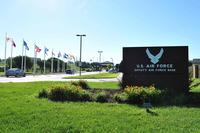A common tactic of the insurgents in Iraq is to set up a mortar (often in a residential neighborhood), quickly pop off a few rounds at an unsuspecting US or Iraqi military base, and then get out of the area before any response can be made. Next to IEDs, mortar attacks are probably the most common threat faced by most American troops not actively involved in combat. Although most mortar rounds explode harmlessly, plenty of damage and many casualties have been caused by lucky shots. Since the attackers are often making their getaway even as the first rounds start landing, it's very difficult to send a team of soldiers to apprehend (or kill) them even if the source location can be determined. And since the insurgents prefer to fire from built-up areas thick with civilians, a simple artillery barrage isn't an option. Mortars are small and fairly easy to use, which means that large numbers of operators are available and they can pretty much come and go as they please.
Since the attackers are often making their getaway even as the first rounds start landing, it's very difficult to send a team of soldiers to apprehend (or kill) them even if the source location can be determined. And since the insurgents prefer to fire from built-up areas thick with civilians, a simple artillery barrage isn't an option. Mortars are small and fairly easy to use, which means that large numbers of operators are available and they can pretty much come and go as they please.
A number of things have been tried to counter-act the mortar threat. The AN/TPQ-37 Firefinder Weapon Locating System, originally designed to track incoming artillery rounds from long range, simply wasn't up to the job of picking up mortar rounds and calculating the firing location.
About the same time as that article appeared, another appeared on USMC.mil about a new system, the Lightweight Counter Mortar Radar, that was being tried out in Iraq with some success. The LCMR is used to track incoming rounds and feed target data to counter-fire units.
Getting back at those firing on you is all well and good, of course. But it doesn't stop the incoming rounds from harming you or your installation. And, as noted, the insurgents prefer to fire from the relative safety of civilian neighborhoods. They've learned that American counter-fire is quick and deadly, and the mortar teams that have survived have adapted their tactics to negate American firepower. So the military is working hard to find a way to shoot down incoming rounds.
Since laser defenses are still quite a way off, the Army has looked to an existing system to fill the need. The Navy's Phalanx CIWS system, an autonomous 20mm gatling gun capable of firing up to 4,500 rounds per minute, has been modified to defend ground units.
Known as "R2-D2" to Navy personnel, the Army is hoping to use these droids to defend bases. The program is called C-RAM, short for "counter rocket artillery mortar" system, and two test units arrived in Iraq last month.
R2-D2 is merely part of an integrated system. The previously-mentioned LCMR and the AN/TPQ-36 Target Acquisition Radar, the AN/TPQ-37's shorter-range brother, feed information on incoming rounds into R2-D2 and it opens up in an attempt to shoot them down. At the same time, a Hunter UAV is dispatched to the calculated firing position in an attempt to attack the attackers with laser-guided Viper Strike missiles or at least track them so they can be intercepted by ground forces.
The naval Phalanx systems fire depleted uranium or (more recently) tungsten armor-piercing rounds. On the high seas, all these heavy rounds falling to the surface aren't much of a problem. But in crowded urban environments this would present a very serious danger to friendly forces and civilians. So instead of using the AP ammunition, the C-RAM uses the HEIT-SD (High-Explosive Incendiary Tracer, Self-Destruct) ammunition originally developed for the M163 Vulcan air-defense system. These rounds explode in mid-air, raining shrapnel at the incoming rounds in order to destroy or deflect them.
--Posted by Murdoc
R2-D2 vs. Mortar Rounds
© Copyright 2025 Military.com. All rights reserved. This article may not be republished, rebroadcast, rewritten or otherwise distributed without written permission. To reprint or license this article or any content from Military.com, please submit your request here.









